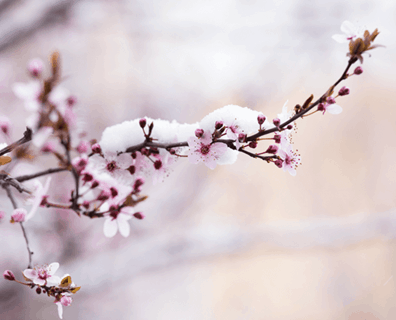Cherries are fruits with high economic value, but there are also many problems in the planting of cherries. Once these problems occur, they will cause huge losses to fruit farmers. Therefore, early consideration of solutions for these problems and early protection can avoid problems and reduce losses.
Heavy Rain
In the two weeks when the cherries are about to ripen, the cherries are most afraid of rain, especially for several hours of heavy rain, followed by several hours of sunshine. At this time, because the cherries are almost ripe and their skins are very thin. Thus excessive water will be absorbed by the skin, and the skin will burst after exposure to the sun. Then cherry diseases will happen after that, such as brown rot (Monilinia laxa) and gray mold (Botrytis cinerea). All of these can cause cherries to rot and decreases their production. This has happened repeatedly in many cherry-growing countries.

In 2019, heavy rain in the Linden area of California destroyed more than half of the cherries in this area.
“If it rains heavily when the harvest season comes, it could be devastating for cherries.”
Bruce Blodgett, Executive Director of the San Joaquin Farm Bureau Federation said,
This is also the common nightmare of most cherry plantations in the world. When the cherries begin to ripen and everything is ready, the growers are happily waiting for a bumper harvest, but heavy rain may ruin all of this.

Solution: Add a PE tarpaulin to the cherries and improve the drainage of the root zone. This is undoubtedly a good solution. Many cherry farms try to cover the cherries with a rainproof tarpaulin in the last three weeks before the cherries are harvested, which can effectively avoid cherry cracking and mold after the rain.
Hailstone
The damage that a hailstone can cause to cherries is often catastrophic, especially when the cherries are about to ripe. Not only the fruits that ripen immediately are destroyed, but even the cherry trees that have been planted for many years may be seriously damaged.

Before Christmas in 2018, a hailstorm hit Australia and caused huge losses in New South Wales. 50% of the cherries in many cherry orchards were destroyed. According to statistics, this unexpected hail caused about US$4 million in losses to local fruit farmers.

Similarly, in Chile, a hailstorm hit central and southern Chile in November 2018. The size of the hailstones was as big as a golf ball and that lasted about 20-30 minutes.
“This weather event caused different degrees of damage in different regions. In Codegua, some farms’ crops were even damaged by 100%. Compared to the previous season, cherry production decreased by 7% in 2018.”
Sofia Silva, Regional Director of ProChile said,

Solution: The installation of anti-hail nets can effectively reduce the huge hailstone damage of cherries and other fruit trees and avoid unnecessary economic losses. Now many areas that suffered hail disasters have prepared anti-hail nets to prevent such disasters in the future.
Late frost

Cherries are an early-maturing tree that easily blooms before late frost. At this time, the late frost in spring will damage them. A temperature of 28 degrees Fahrenheit will cause a 10% loss, and 24 degrees Fahrenheit will cause a 90% loss in fruit trees. If a huge amount of pistils are lost in frost, it will directly affect the final cherry yield.

Solution: Experienced fruit growers provide many ways to deal with frost, such as
- Choose cherry varieties that can withstand the cold. Some cherry varieties have a natural resistance to severe cold and can adapt to lower temperatures.
- Choose natural frost-proof locations for planting, such as places near rivers. But these locations may be relatively expensive.
- Install heaters, fans, or use helicopters. Of course, the price of using helicopters is very expensive.
- Install an anti-frost net/cloth for the orchard. This method is like wearing a piece of clothing for the orchard, which can effectively prevent damage to the low temperature.
Birds

Usually, birds are natural enemies of fruits. When the fruits are gradually ripe, their color turns red, and the cherries give off a delicious smell, all kinds of birds will fly in groups to enjoy the feast. The farmers must do everything possible to drive away these birds. Common birds that like eating cherry include American Robin, Baltimore Oriole, Blue Jay, Cedar Waxwing, Downy Woodpecker. Evening Grosbeak. Gray Catbird. Hermit Thrush.
Solution:
- Install items that frighten birds: such as cloth belts floating in the air, frightening balloons, etc. You can also put some shiny things, such as old DVDs, rolled tin foil and so on. But these items must be replaced frequently because once the bird gets used to them, this method will fail.
- Feed the birds with other foods: You can throw some foods that birds like beside the orchard, such as corn, millet, and peanuts.
- Make some noise: For example, hang some aluminum cans on trees, or use some sound generators.
- Install anti-bird net: cover a layer of anti-bird net above the cherries, which can effectively isolate these birds. This method is considered to be the most effective anti-bird method at present.

Keep these methods in your mind! Wish your cherry orchard have a good harvest!
We Eyouagro also weave custom nets to any weight, dimension, or opening requested, If you are interested in Hail Netting,Bird Netting,Frost cover and Rain cover, contact us and we would be happy to help you decide which product is right for you.









